There’s a lot you don’t know about Svalbard.
I didn’t know much about this little island in the Norwegian Arctic before I arrived either – but after spending a week in the midnight-sun-soaked Svalbard in summer, I can say it’s probably the most unique place I’ve ever travelled to.
I arrived in Svalbard after two weeks spent sailing on an expedition ship from Scotland and up the coast of Norway, before we crossed over the Arctic Circle and into another world. As I disembarked with my fellow passengers at Longyearbyen harbour, most of them headed straight for the airport – but I had a full week ahead of me to explore the town of Longyearbyen and the environment of Svalbard beyond it.
Most people tend to visit Svalbard to see either the midnight sun or the northern lights, but there’s so much more on offer. Life above the Arctic Circle is beautiful, eerie, and surreal: it’s a place where polar bears outnumber people, where no trees grow, and where you’re not allowed to die.
Here are the most unexpected facts I learned during my week in Svalbard at the top of the world.
Pin me for later!
1. During a Svalbard summer, the sun never sets.
Between May and September, you’ll experience a phenomenon known as the ‘midnight sun’, where the sun is fully visible all day and night. It happens in places north of the Arctic Circle and south of the Antarctic Circle because the earth’s axis is tilted more towards the sun.
When the midnight sun arrives, the skies at midnight look like it’s dusk, or early evening: there’s a pinkish tinge to the air, and the sun shows no signs of setting all night.
As a result, it’s worth getting accustomed to a 24 hour clock, just in case you accidentally turn up somewhere twelve hours early. It happens.
2. Constant daylight is worse than constant darkness.
The downside of living under the midnight sun is that it screws with your circadian rhythm – and constant light is actually harder to cope with than the constant darkness of polar nights.
From November to January in Svalbard the sun doesn’t rise, but it’s not actually pitch black; it’s more like a constant blue-tinged dusk. Importantly, your body still understands that it needs to sleep.
However, when there’s sunlight at night your body finds it hard to adjust. During my week in Svalbard I felt wide awake much later than usual, despite the thick blackout curtains hung across the windows of my hostel dorm room. And one night I emerged from Longyearbyen’s pub at 1am to the utter confusion of bright sunlight outside! I felt delirious and disorientated walking down the deserted road.
You never realise the full importance of day and night until the concept no longer exists.
3. There’s some confusion over what this place is actually called.
Longyearbyen, Svalbard, Spitsbergen, and Jan Mayen: this part of Arctic Norway has a few different names, which can get a bit confusing if you’ve never visited. This is how I understand it:
- Svalbard is the official Norwegian name of the archipelago. This group of islands are separate from the mainland of Norway, flanked by the Greenland Sea and the Barents Sea, and they’re the closest inhabited landmass to the North Pole.
- Jan Mayen is an island separate to Svalbard, but they’re administratively linked so are often referred to in the same breath. Jan Mayen is about 900 km from Svalbard, has just eighteen inhabitants and requires special permission to visit, so tourism is rare.
- Spitsbergen refers to the largest island of the Svalbard archipelago. It’s a Dutch name, dating back to the island’s discovery by the Dutchman Willem Barentsz in 1596.
- Longyearbyen is the ‘administrative centre’ of Svalbard and is on Spitsbergen island, but it’s easier to refer to Longyearbyen as Svalbard’s de facto capital because it’s the only significant town in the archipelago – there’s an airport, harbour, school, swimming pool, supermarket, art gallery and museums, and it’s where all the hotels and restaurants are located.
- Barentsberg is a small Russian mining settlement, also on Spitsbergen island. It’s about an hour from Longyearbyen and has about 400 residents.
To allay any confusion on your arrival, there’s a helpful road sign welcoming you to Longyearbyen – despite the fact it’s entirely unnecessary. There are no other road connections to any other settlements in Svalbard.
4. Svalbard doesn’t belong to Norway… but it’s not its own country either.
Svalbard is an area of the world under Norwegian control, but it’s not officially Norway.
Confused? Me too.
In fact, Svalbard is international land (as agreed by the United Nations). The Svalbard Treaty of 1920 allows any person, regardless of their nationality or citizenship, to enter Svalbard freely – which is why so many non-Norwegians live and work here. There’s no need for visas or work permits: as long as you make your own way to Svalbard, nobody can tell you to leave.
This treaty is used by immigrants and asylum seekers who’ve been denied residency in Norway or mainland Europe. If they can plant their feet on Svalbard’s permafrost soil then they’re able to stay, but they still have to be able to find a job and support themselves.
NB: although officially you don’t need a visa to enter Svalbard, the only viable entry points are on domestic flights from Norway (Oslo and Tromso) which do require a Norwegian visa.
5. There’s no shortage of jobs, but there IS a shortage of housing in Svalbard.
Coal mining is the main element of Svalbard’s economy – but thanks to the growing tourism industry, it’s also possible to find seasonal work in the hotels, restaurants, and bars. If you have experience working with dogs, you could work at the kennels – and excellent skiers could get a job as a guide (as long as they’re comfortable with shooting a gun).
However, there’s a finite amount of space to build accommodation, meaning it can be tricky to find somewhere to live. There’s barely any privately owned housing in Svalbard: instead, you’re provided with accommodation alongside your employment.
Although you can find Svalbard apartments on Airbnb, your best bet is by paying per night at a hotel or hostel.
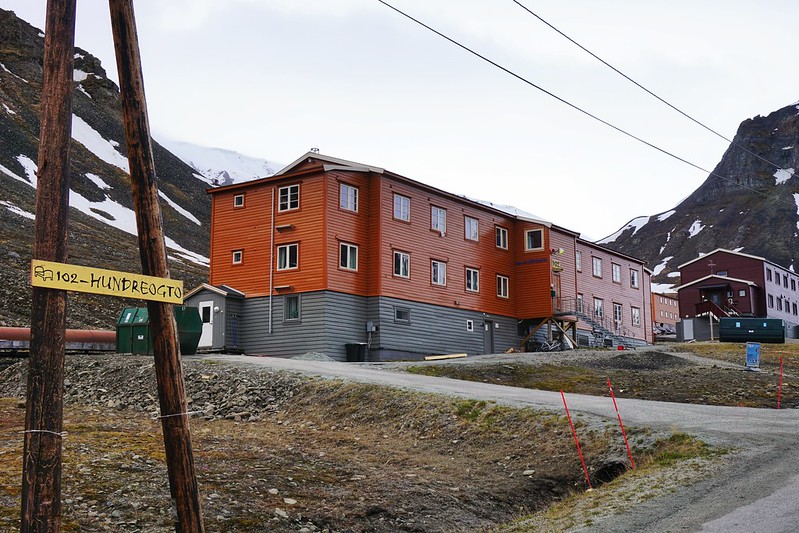
I stayed at the Gjestehuset 102 hostel which was pretty reasonable!
6. Svalbard’s tiny population is extremely multicultural.
Life at the top of the world is an intriguing idea, and Longyearbyen is home to an eclectic mix of around 2,000 people from 50 different countries. Norwegians make up the majority but there’s also a big Thai community and people from Germany, Sweden, Denmark and Poland. Officially there are lots of Russians too, but they mainly live in Barentsberg.
The official language of Svalbard is Norwegian, but with so many different nationalities living and working in Svalbard, it’s easy to get by speaking English. During my visit to Svalbard the barman was from London, but he hadn’t really learnt Norwegian because there was barely anyone to practice with!
7. There’s no public transport in Longyearbyen.
Although the fancier hotels do operate a shuttle bus service around the town, there’s no public transport in Longyearbyen. Luckily, everything in the town centre is walkable – it took me about 40 minutes to walk from the harbour to my hostel at the far end of town.
If you don’t want to walk, there are taxi companies like Svalbard Maxi Taxi and Longyearbyen Taxi, and a shuttle bus operates from the airport to the town centre.
For trips outside of Longyearbyen, you’ll be taking other forms of transport like buses, boats, ATVs, snowmobiles and even dog sleds.
8. Visiting Svalbard in summer might mean a lack of snow-related activities.
Average summer temperatures in Svalbard are between 3 – 7’C (37 – 44’F) – but the strong rays of midnight sunshine can make it feel warmer.
This can lead to melting snow, so be prepared for some snow-based activities to be compromised or unavailable. (I say compromised because dog-sledding was apparently still available with no snow cover – but when I learned that the dogs would have to run on asphalt while wearing little socks I decided against it!)
On the upside, warmer temperatures meant I was able to visit the abandoned site of Pyramiden, a Russian mining settlement which is now a ghost town. There’s a small window of opportunity for this as during much of the year the water at the harbour freezes over and no boats can access it.
Read more: Exploring Pyramiden, the Arctic’s Soviet ghost town
9. You don’t actually want to see an Arctic polar bear in Longyearbyen!
It’s estimated that there are over 2,500 polar bears in Svalbard (more than the number of permanent residents in Longyearbyen!). They’re nonetheless an endangered species and have been protected by international law since 1973, which means no polar bear safaris or guided tours – but that doesn’t mean you won’t see one.
Bears roam the entire archipelago, and there have been occasional attacks on people in Svalbard. If you go to Pyramiden, you’ll no doubt hear of the break-in at the Hotel Tulipan, where the trespassing polar bear proceeded to lick up traces of spilled beer at the hotel bar.
To remind tourists of the dangers, there are warning signs dotted around Longyearbyen’s borders. Great for a photo, but a little chilling when you think about what they’re warning against…
Read more: The day I saw three polar bears in Svalbard
10. Outside Longyearbyen, it’s illegal to NOT carry a gun.
Thanks to the thousands of polar bears which roam Svalbard, Longyearbyen is the only part of the archipelago where you aren’t legally required to carry a gun.
Outside of town limits it’s illegal to be without a firearm: you have to be accompanied by a guide carrying one, or be proficient in handling a rifle or shotgun yourself. All the students at Svalbard University are also trained to use firearms.
11. Shooting a polar bear anywhere in Svalbard is a criminal offence.
Because of the aforementioned laws protecting polar bears, it’s a big deal if they’re purposefully affected by humans in any way. It’s considered a criminal offence to hunt, feed or disturb a polar bear, and anyone committing these acts faces trouble.
You can read the laws about firearms in Svalbard here.
Fun fact: polar bears in the Arctic really are ‘armoured’ – because they have a layer of blubber a few inches thick which can stop smaller rounds from a gun.
12. But it’s basically impossible to commit a crime in Svalbard.
Although there’s plenty of firearms around, Svalbard is still a pretty safe place to live because there’s nowhere to hide. The most violence Svalbard sees is due to bar brawls – there were nine in 2013, but just one in 2012.
One Redditor who used to live in Svalbard said he once walked into the Longyearbyen bank with a ski-mask, a loaded rifle and the teller just nodded at him. Unfortunately, this was eclipsed in 2018 when a Russian man actually tried to rob the bank. He was quickly arrested but it’s made inhabitants a little more aware of modern-day dangers.
13. In Svalbard, reindeer are as unconcerned by people as your neighbourhood squirrel.
Svalbard reindeer are a subspecies with short legs, little round heads and a generally adorable appearance. Although not domesticated, these reindeer have no natural predators on the island so they’re perfectly happy to wander through town and aren’t scared off by people around them.
You’ll easily be able to spot a local versus a tourist from how they react to reindeer: the animals are such a common sight in Longyearbyen that the locals tend to ignore them.
14. You won’t see a single cat in Longyearbyen.
Thanks to the rich variation of Arctic birdlife in Svalbard, the archipelago is a top birdwatching destination: think ptarmigans, snowy owls, guillemots, auks, scuas, and let’s not forget my absolute favourite, the puffin – I even wrote about my experiences seeing them for National Geographic!
Unfortunately, that means cats are prohibited from living on the archipelago thanks to their natural inclination to catch birds – or their ‘disruption to local wildlife’. However, the occasional cat does make it through – like this ginger cat who apparently made it to Barentsberg, the Russian town close to Longyearbyen.
In comparison, dogs are much more common in Svalbard – huskies specifically. These boys work as sledding dogs, and take tourists exploring in the Svalbard wildnerness year-round.
(I’ve never been dog sledding but The Planet D’s article is a good resource for people worried about the ethics behind it.)
15. You might get attacked by angry birds.
The Arctic tern is the only tern breeding in Longyearbyen, and they nest alongside the coastal road leading to the husky kennels. If you’re walking along this stretch of road, make sure to take a long stick and hold it above your head: Arctic terns are extremely protective of their nests, and they attack the highest part of a predator by dive-bombing them with furious pecking and a lot of noise.
It’s pretty terrifying, but these birds are winners at commanding respect. After one round of being dive-bombed I never walked along this road again!
16. Every building on Svalbard is up on stilts.
Much of the earth beneath Longyearbyen is permanently frozen solid throughout the year, thanks to what’s called a permafrost. However, a layer of it does melt in the summer months and refreezes as it gets colder again, which causes the ground to be soft and unstable.
Longyearbyen’s buildings are set on metre-high stilts driven deep into the ground so the heat they emit doesn’t melt the ice beneath. Unfortunately, globally rising temperatures mean the permafrost in Svalbard is melting at an accelerated rate in spite of the precautions in place.
17. Nobody is allowed to die in Svalbard.
Longyearbyen has a small cemetery on a hill at the edge of town, but nobody has been buried there for over 70 years. Why? Because in the 1950s, residents discovered that the bodies buried in Longyearbyen’s graveyard weren’t decomposing because the permafrost was delaying the process.
More worryingly, the first bodies to be buried were a group of Norwegian miners who’d died from the Spanish flu in 1918. Amid concerns that these corpses could still carry the active virus, and could re-infect people if the permafrost ever thawed, burials in Longyearbyen were stopped indefinitely.
It’s now forbidden to die in Svalbard. If you fall ill on the archipelago you’re sent to the mainland, and if you’re unlucky enough to die here you won’t be buried either – all bodies are shipped back to Norway for burial.
Cremated remains in urns can, however, be buried in the cemetery.
18. Abandoned buildings don’t decay in the Arctic.
The permafrost and the Arctic’s dry, cold climate means most of Svalbard’s buildings are impervious to rot and decay – or, at least, decaying happens very slowly.
There are also strict cultural heritage laws in Svalbard: any evidence of human activity dating from 1945 or earlier has to be left as it’s found, thanks to the Svalbard Environmental Protection Act.
Thanks to these combined elements, there’s a sense of living history throughout the archipelago. You’ll come across tiny cabins which haven’t been inhabited in decades and whaling boats left upturned on the shoreline – and you’ll wonder who last used them for their true purpose.
19. Svalbard’s history is a little bloody.
While present-day Longyearbyen is known for coal mining, Svalbard in its entirety was centre-stage for hunters and trappers as far back as the 17th century, when the islands were nothing but vast wilderness waiting to be explored.
The furs from polar bears and Arctic foxes were worth a lot of money; the Svalbard reindeer and ptarmigan birds were hunted for their meat; and the practice of whaling virtually took over the Svalbard coastline and surrounding seas throughout the 17th and 18th centuries until the whale was virtually extinct.
Most of these activities thankfully no longer exist – although commercial whaling is still an official practice in Norway, which is in defiance of a ban imposed by the International Whaling Commission in 1986.
20. There are no trees in Svalbard.
You’d think no trees would make for quite a barren landscape – and it does, except that the flora (!) close to the ground is fascinating in its own right. There are all types of grasses, lichens, mosses, and tiny hardy flower species which manage to eke out an existence amidst harsh winds and chilly temperatures.
Longyearbyen is also a very clean place to visit, as Svalbard’s environmental protection laws prevent visitors from picking flowers or leaving any trash in the archipelago.The aforementioned cultural heritage laws also means you’ll occasionally see whale bones amongst the moss and flowers – a surreal sight.
21. Fresh groceries can be expensive – but alcohol is cheap!
Because it’s hard to grow fresh produce in Svalbard, most products are imported and they don’t stay fresh for long. Fruit and vegetables have to be flown in quickly rather than shipped in more slowly, which makes them seriously expensive. (On the plus side, if you’re not a vegetable fan there’s much less pressure to get your five a day!)
In comparison, alcohol is much cheaper here than in mainland Norway because (1) it’s non-perishable and (2) Svalbard is a tax and duty-free zone. Before you stock up though, just remember you’ll have to declare excess liquor at customs on your return to mainland Norway.
22. Take off your shoes everywhere.
There’s a long-standing tradition in Svalbard to remove shoes before entering hotels, restaurants and some shops.
It dates back to the coal mining days when coal dust was a constant annoyance and now just seems polite – so if you see a shoe-rack inside the entrance to a building, expect to unlace your boots and wander around in your socks.
23. If you have an Arctic bucket list, you can tick off the ‘northernmost’ everything
The world’s northernmost town: check. The world’s northernmost graveyard: check. And how about the world’s northernmost airport, swimming pool, hospital, kindergarten, hotel, and pub while we’re at it?
As the northernmost settlement of any kind, Longyearbyen and Svalbard hold a ton of ‘northernmost’ accolades. In fact, I’d wager a guess that for my week-long stay in Svalbard, I was the world’s northernmost Flora!
24. Santa Claus collects his Christmas mail in Longyearbyen.
Longyearbyen is 650 miles away from the North Pole, making it the optimum spot for Santa Claus to receive his post.
There’s a giant letterbox installed close to the harbour where you can add your own Christmas letters to his sack – although there still haven’t been any December sightings of the man himself.
25. Even at the end of the world, you might miss out on a bed!
Accommodation options are limited to a handful of hotels, a few hostels and one campsite in Longyearbyen – and these tend to fill up extremely quickly during the summer months. Make sure to book your hotel or hostel far in advance.

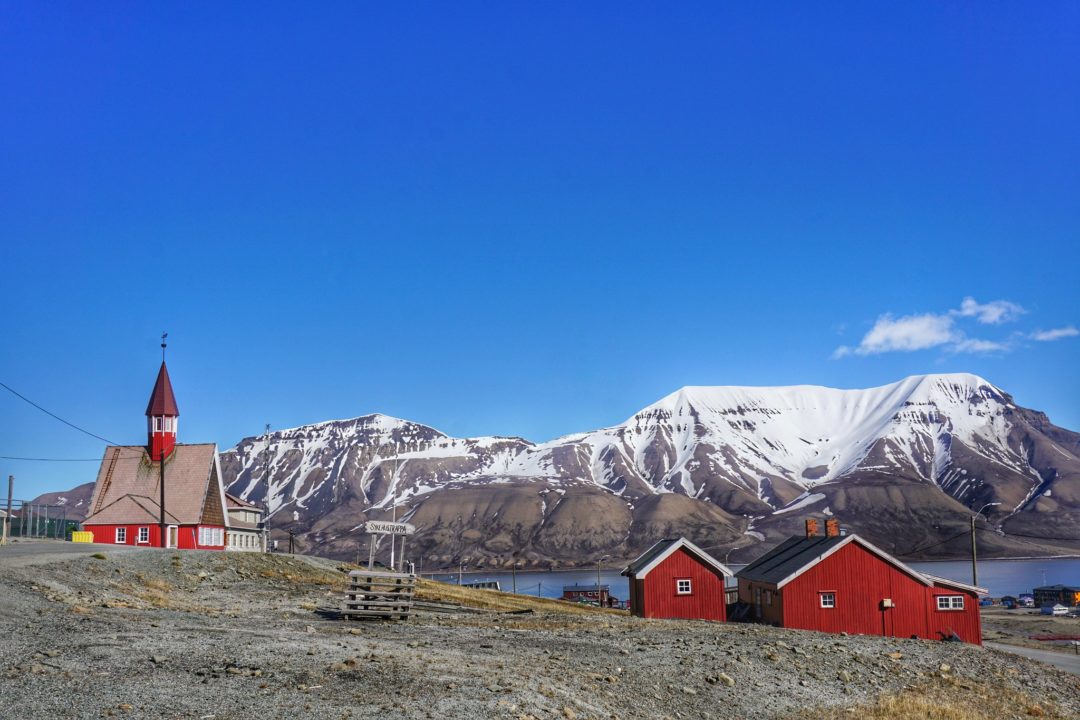
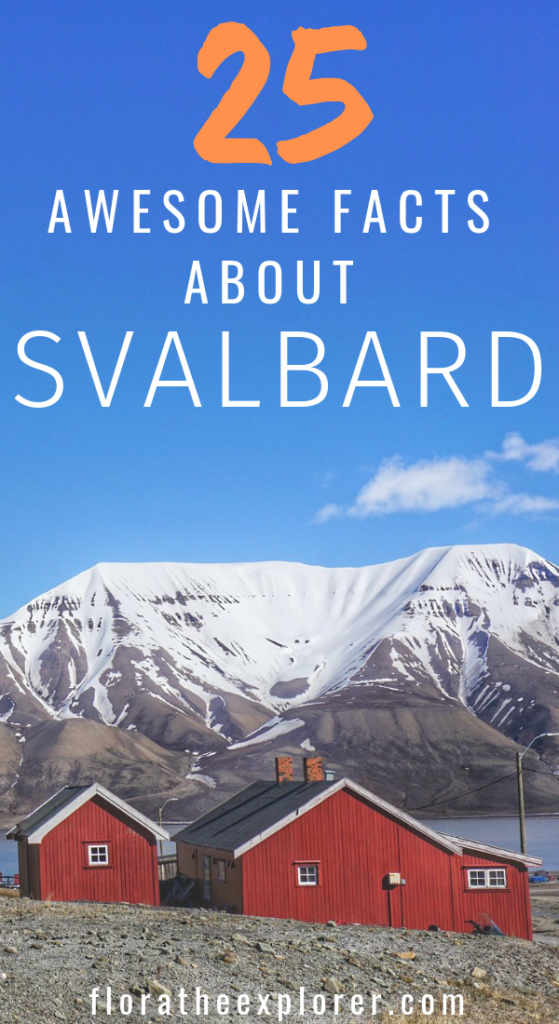



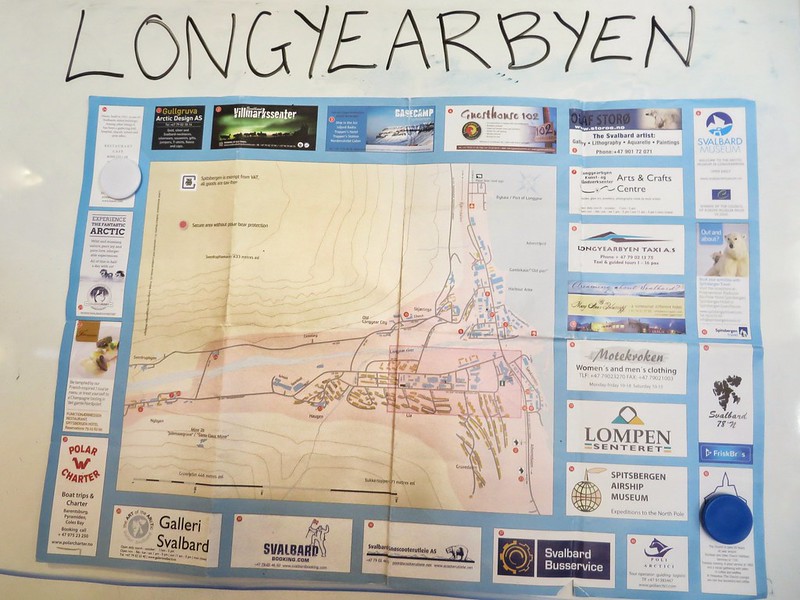


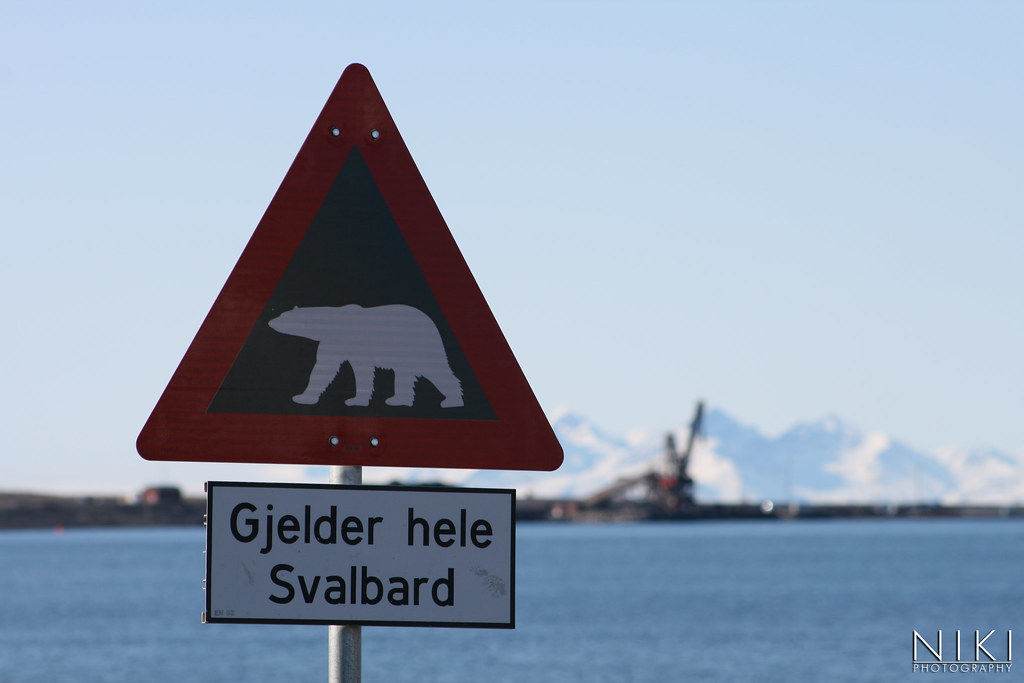
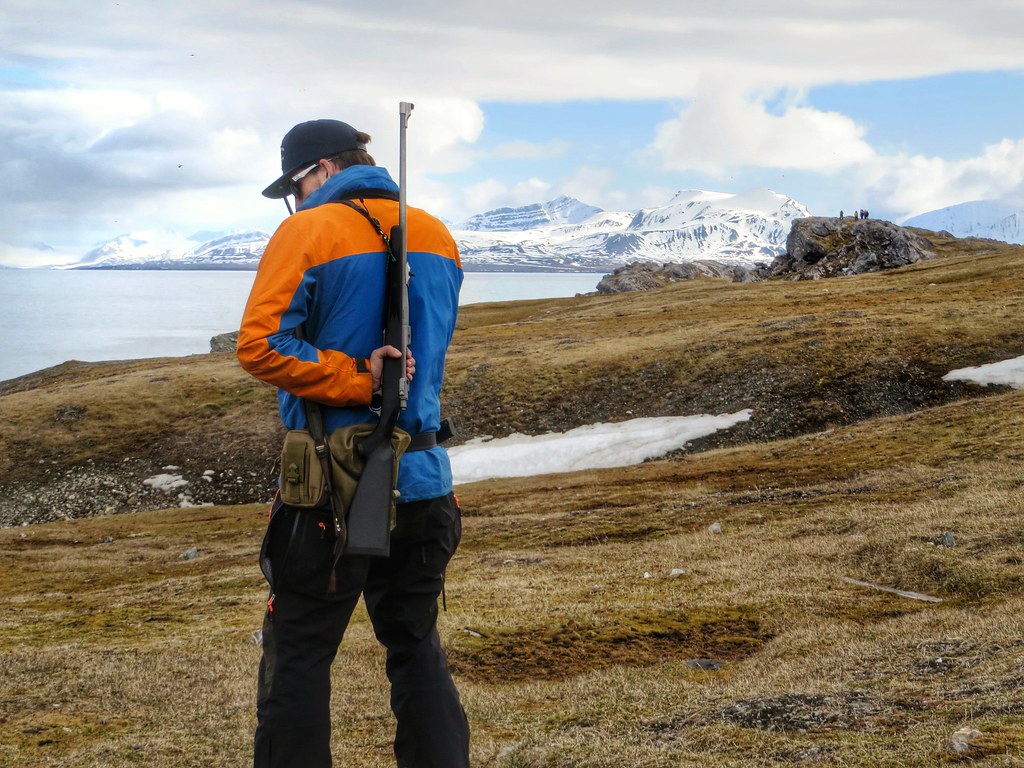
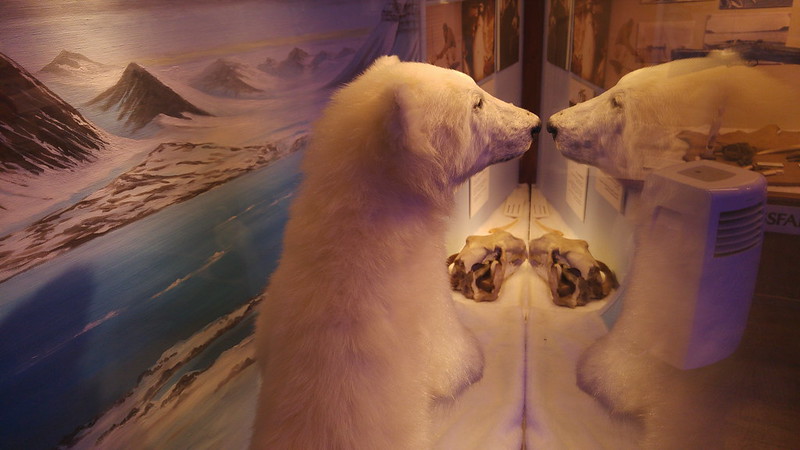




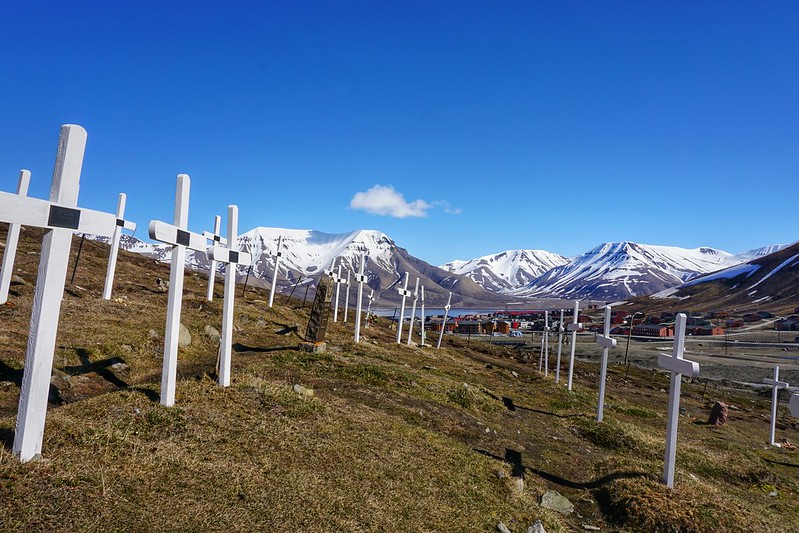



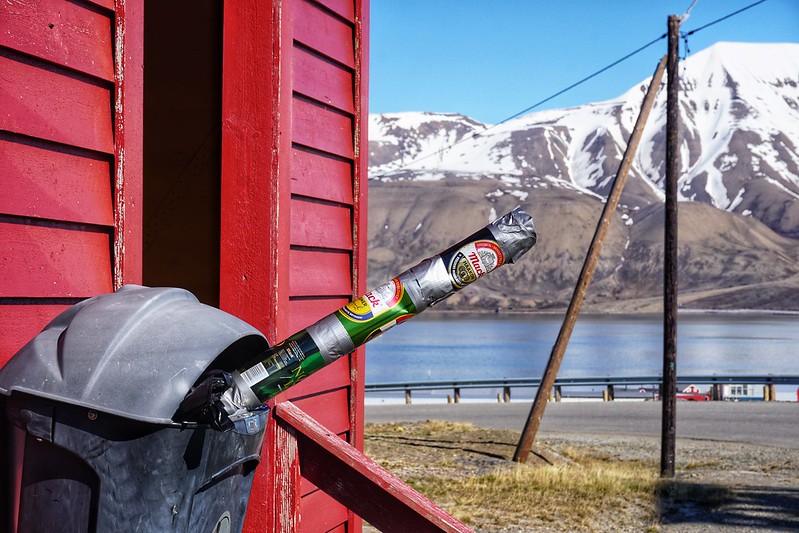


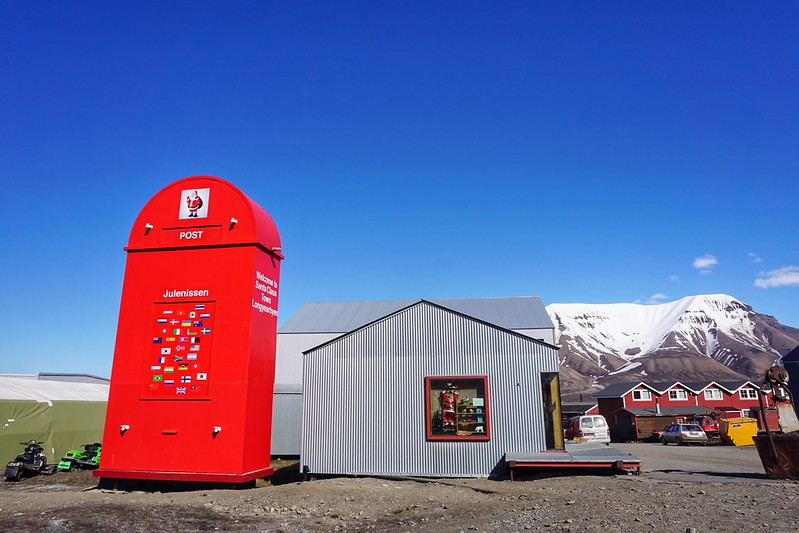
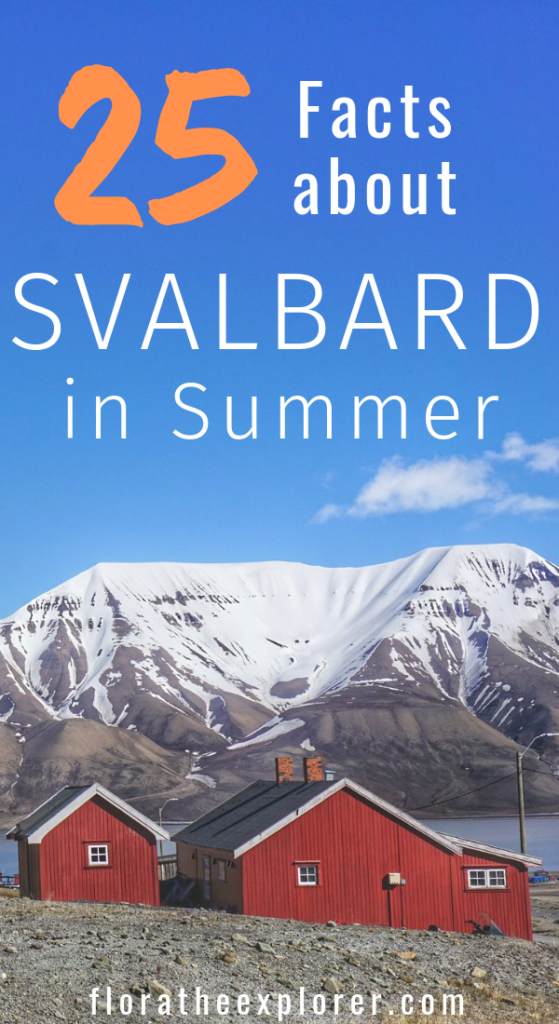
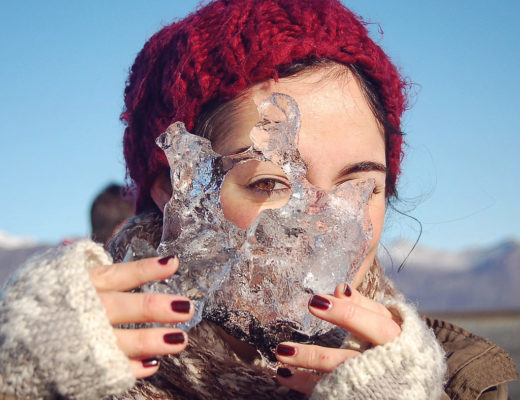
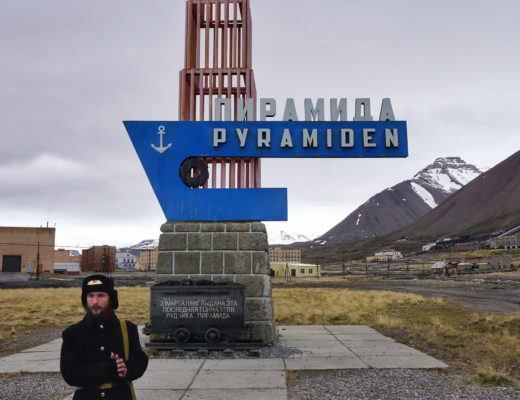
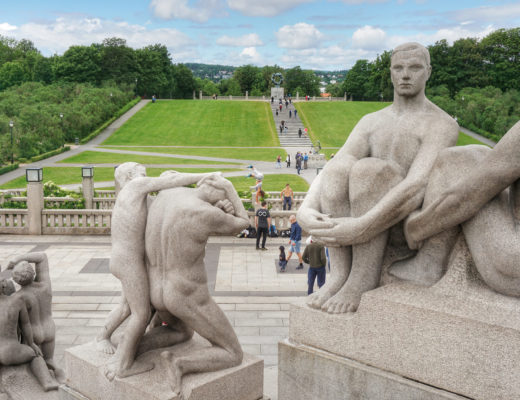
17 Comments
rachelsb3
June 29, 2019 at 9:11 amSvalbard in summer has been on my bucket list for a while – I’ve always been fascinated by the midnight sun – but I didn’t know lots of these facts, so this was an interesting read! I’m intrigued as to how there ended up being such a multicultural population, and I love that Santa collects his mail there!
Flora
August 24, 2019 at 1:47 pmI hope you make it there Rachel – it’s such a fascinating place to visit! It’d be awesome to see how kids react to Santa’s mailbox too 🙂
Lauren
June 29, 2019 at 10:19 amLOVED this! never heard of Svalbard before but I’m definitely more of a snow worshipper than sun worshipper so would definitely be my kind a place! Cannot believe that about carrying a gun because of polar bears!!
Flora
August 24, 2019 at 1:48 pmThanks Lauren! I love the term ‘snow worshipper’ – and I’m definitely the same 😀
G. Isabelle
June 29, 2019 at 1:34 pmWhoaaaa! First, I had NO idea about Svalbard.. Second… this is a super interesting island.. I ever thought about how the arctic cold influences something like a burial… and how interesting to think that you could freeze a VIRUS from 100 years ago. Super interesting place… it’s now on my bucket list!
Flora
August 24, 2019 at 1:50 pmIsn’t it crazy how much impact extreme weather conditions can have?! Hope you make it to Svalbard eventually – I’m sure you’d love exploring it!
annk89
June 29, 2019 at 6:00 pmThis island sounds super awesome and unique! Loved reading all these interesting facts and would love to visit there someday!
Flora
August 24, 2019 at 1:51 pmThanks Ann! Svalbard is such a interesting place 🙂
Frances Thompson
June 29, 2019 at 7:16 pmThere really is a lot I don’t/didn’t know about Svalbard. Thank you for educating me. I’ve travelled a lot in Arctic Circle and Lapland and so thought I had pretty much done what I wanted to do but you have now convinced me otherwise!
Flora
August 24, 2019 at 1:53 pmI really want to head to Lapland! And now, after Svalbard, I’ve got such a hankering to see so many other parts of the Arctic too..!
Live Love Run Travel
June 29, 2019 at 8:20 pmI love all these tips! I didn’t know any of this going in to this post – especially interesting to me is that you have to carry a gun to protect yourself, you can’t die there, and the buildings not really rotting or decaying. I’d love to visit one day, and I appreciate you sharing this information.
Flora
August 24, 2019 at 2:00 pmThe gun rule in Svalbard is probably one of the strangest things I’ve ever come across on my travels!
Laurie
July 2, 2019 at 2:06 amLoved your post on Svalbard. Now, it’s on my bucket list to visit!
Flora
August 24, 2019 at 1:50 pmGlad to hear it Laurie!
Amy Wilson
February 22, 2021 at 4:42 amI had never heard of this country until about an hour ago and now I am completely, fascinatingly obsessed. Thank you so much for this amazing and informative article!
hihi2121
February 21, 2023 at 5:38 pmomg i know about it now!
avi
July 1, 2024 at 7:18 pmhi Flora,
do u recomemend taking kids to svalbard in summer for 2 nights, do we polar bear tours which may interest childern